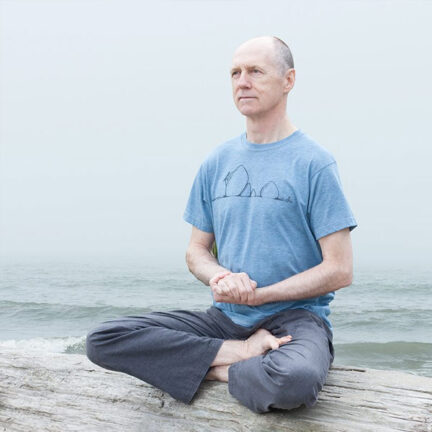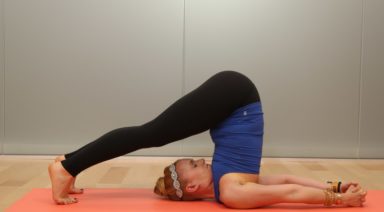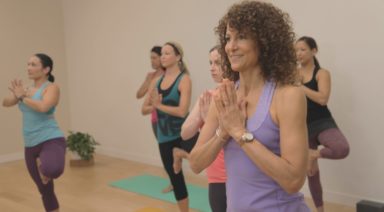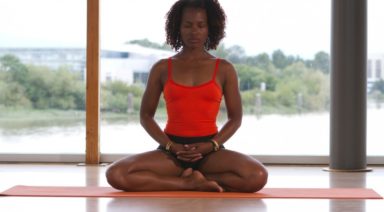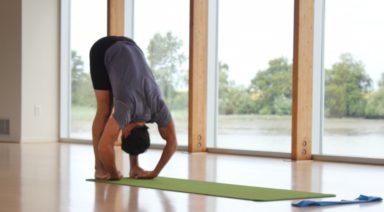The Yin Side of Breathing: Benefits of Yoga

“It can be argued that stress is the number one killer in the Western world today.”
Dr. Timothy McCall
In his book, Yoga as Medicine, Dr. Timothy McCall goes on to say,
“… stress fuels some of the biggest health problems of our time, including type 2 diabetes, depression, osteoporosis, heart attacks and strokes as well as autoimmune diseases like multiple sclerosis (MS) and rheumatoid arthritis. While there isn’t a lot of evidence that stress causes cancer, it appears to increase the odds of dying from the disease.”[1]
Whew … stress! Who needs it? Stress is unavoidable in our culture and some amount of stress is actually needed for our bodies to be strong and healthy. All exercise includes the dual components of stress and rest. However, when we experience too much stress and not enough rest, problems arise. In physiological terms we are hyperactive in our Sympathetic Nervous System (SNS) and hypoactive in our Parasympathetic Nervous System (PNS). The SNS and PNS are part of our autonomous nervous system, and our yoga practice, especially the Yin Yoga practice, can help rebalance these two important systems.
Reduce Stress Through Meditation
Whether you’re looking to cultivate more authenticity, increase happiness, improve relationships, or reduce stress, all of these things are accessible to you through the practice of meditation. I’m leading a new meditation guide called Here & Now: A Beginner’s Guide to Meditation right here on Gaia. Learn how you can transform your life in this video.
Before we examine how Yin Yoga, combined with mindful breathing, can help reduce our stress levels and dial back the SNS, let’s look a bit more at what these two systems do.
The Sympathetic Nervous System
The SNS is our basic fight or flight system. When our ancestors were being chased by a sabre-tooth tiger or being attacked by the tribe in the next valley, their SNS would strongly activate and give them the energy and focus needed to flee, or fight. The brain’s amygdala recognizes the threat and stimulates the hypothalamus, which in turn releases hormones that activate the pituitary gland. The pituitary then releases hormones that cause our adrenal glands to release several other hormones including adrenalin, which speeds up our heart and respiration rates, and cortisol, which temporarily enhances our immune system.
Stimulating the SNS diverts blood from the digestive organs to our muscles: who needs to digest now when the most important thing is to run for our lives? Often, when we are really stressed, our bowels loosen: diarrhea helps to lighten the load so we can run faster.[2] Our blood thickens: coagulating factors are released into our blood to help us stop bleeding if we are cut. Our ability to focus is temporarily increased and memories can be imprinted for the rest of our lives.
Today, our bodies react in the same way to threatening signals from our environment, but there are few sabre-tooth tigers around to really scare us. Our stresses are mostly caused by our way of viewing our life, not by actual external threats. The neighbouring tribe may be your ex-mother-in-law or boss. Where our ancestors might have encountered a stressful situation once or twice a week, we are faced with stressful situations constantly. Simply listening to loud music, watching the news, listening to a friend complain about her life, viewing commercials, eating hot or spicy foods, watching action movies can all trigger our SNS. This is in addition to the stresses we encounter daily in our jobs, in our relationships, in commuting to work each day. We are in a constant state of SNS activation: we are over-stressed.
The result of chronic stress is chronically high levels of cortisol. High cortisol levels are linked to elevated fasting blood sugar levels, higher blood pressure and insulin resistance. We may begin “food seeking behavior” due to our stress: Dr McCall noted a study that found stressed out children will consume more than twice as much food as their calmer fellow students.[3]
While a temporary spike in cortisol can sharpen our mental focus, a continually elevated cortisol condition will lead to poor mental abilities, decreased memory and a depressed immune system. Our blood viscosity remains too thick, causing many heart problems. Bone loss, insomnia, poor wound healing, weight gain, depression and fatigue are all a consequence of prolonged stress.
The Parasympathetic Nervous System
The PNS works in the opposite direction: it is our rest and digest response. Through stimulation via the nerves running to our internal organs (primarily the vagus nerve), and through the release of acetylcholine, our heart rate slows and blood pressure drops. Blood flow that was diverted away from the intestines and reproductive organs, whose function isn’t essential in an emergency, returns. Our saliva can be secreted again (ever notice that when you are stressed, your mouth is very dry?) When we relax, our tears can flow.
The second most common neurotransmitter in our central nervous system is called GABA.[4] GABA decreases brain activity: it helps to turn off the lights when we are no longer in a room. If we are stressed, all the lights are on, even if we are not home. Similar to the PNS, GABA helps to reduce our stress response. Our yoga practice, when done properly, can increase our GABA levels and turn on the PNS.
Tapping into the Rest & Digest System
Boston University Medical Center reported in August of 2010[5] that GABA levels and mood are positively affected by yoga practice. The researchers note that low levels of GABA are linked to depression and anxiety. Their study has shown that yoga will increase GABA levels in the brain and improve our mood. But, we don’t need a study (and there have been several[6]) to tell us that we feel better when we do yoga. We just need to know how to tap into the practice more deeply. What is it about yoga that makes us feel so good?
While we are asking questions, how come yoga doesn’t increase our stress levels? We are doing physical work: why doesn’t the effort we put into our practice trigger the SNS?
Certainly, for some people, yoga can be stressful: if you arrive to a class with expectations of having a great class, of doing it “right”, or achieving a challenging posture, of looking good for the ladies, you may well stress yourself out. But, if you allow the practice to just flow and surf your breath, you will successfully master stressless-stress. Effortless effort. Action without acting. Wu-wei. Do without doing.
Surfing the Ocean Breath
The key activity that turns off the fight-or-flight system and activates the rest-&-digest system is breathing. Not just any old breath, but a proper yogic breath. A slow, deep, even breath will create a relaxed nervous system, yielding a calm mind, which in turn will help the breath become slower and more even. A positive feedback loop can be established that increases the effectiveness of the PNS and increase GABA production.
There are many forms of breathwork in yoga (called pranayamas). Some are very active and stimulating, and there are times when these pranayamas are beneficial, but to turn on the PNS, we need the slow, deep pranayama known as ujjayi. Ujjayi means “victorious breath”.[7] A nice modern term for this kind of breathing is “ocean breathing.”
Max Strom in his wonderful book, A Life Worth Breathing, describes the practice of ocean breathing.[8] It is quite simple: imagine you are trying to fog your sunglasses for cleaning. You would naturally make a “haahhh” sound. Try that now. Try to make this sound on both exhalations and inhalations. At first, keeping doing this ocean breathing with your mouth open, until you can create the soft sound of the waves coming ashore habitually, without thinking about it. Only then, move to making the same sound with your mouth closed.
Max says that ocean breathing “enlivens the lungs and expands them, dynamically pulling in fresh air (prana) and then expelling stale air and stress (apana). It is known for calming the mind and can also be very effective for helping to process grief. … You may experience an emotional feeling or even some tears after practicing this breath. If that happens, simply receive it as a healing experience. Afterwards you’ll refreshed and peaceful.”[9]
Krishnamacharya was one of the first teachers to emphasize combining pranayama practice with asana practice. Before him, most yoga teachers segregated these: first we did our asana practice, then we sat down and did our pranayama practice. T.K.V. Desikachar, Krishnamacharya’s son, reports that Krishnamacharya felt pranayama had to be combined with the asana practice. It was by lengthening and smoothing the breath that the body and the mind could be joined together.[10] The pranayama recommended was ujjayi, or ocean breath.
Of course, the yogi was still free to do a complete pranayama practice after his asana practice. This was done while very still, to allow our intention to flow inward, towards the very act of breathing itself. It is harder to be still when we are flowing with our asanas, however, in our Yin Yoga practice, we have long periods of stillness where we can combine the deeper pranayama practice with asana. In his book, The Heart of Yoga, Desikachar suggests,
“In pranayama we focus our attention on the breath. In the practice of pranayama it is therefore very important to keep an alert mind, for the processes that are being observed are very subtle. There is no visible movement.”[11]
Desikachar recommends our attention be first focused on the exhalation. Practice watching your out-breath until you know everything about it. Only then, allow your awareness to encompass the inhalations. Know everything about the in-breath. Don’t worry about the practice of retaining your breath, of holding the breath with lungs full or empty. Save that for a full pranayama practice; no need to do these pauses for more than a second or two while you are doing your Yin Yoga practice.[12]
Instead, work on allowing your ocean breath to lengthen. Notice: we are advising you to allow your breath to lengthen. Don’t force it. Surf the breath. If a surfer fights the ocean, he’ll just get all wet. Flow with the waves of each breath. Desikachar advises that lengthening the breath, while okay, is not the point. The point is to do whatever it takes to stay focused and present, paying attention to the breath. However, there definitely are physiological and psychological benefits to an extended breath.
Chanting Nuns
Professor Luciano Bernardi, of the Italian University of Pavia, reported in a 2001 study that slowing our breath rate down positively affected our heart rate variability[13] and increased baroreflex[14] sensitivity. He studied the effects of chanting the Tibetan mantra Om Many Padme Hum, and he discovered the benefits were identical for people who chanted Ave Marie.[15] In both cases the chanting slowed the breath down to only 6 breaths per minute. His conclusion was,
“Rhythm formulas that involve breathing at six breaths per minute induce favourable psychological and possibly physiological effects.”[16]
A more complicated quote from Bernardi’s study may be useful, but hopefully not too dense.
“A slow respiratory rate (6/min) has generally favourable effects on cardiovascular and respiratory function and increases respiratory sinus arrhythmia[17], the arterial baroreflex, oxygenation of the blood, and exercise tolerance. In chronic heart failure it also reduces the exaggerated sensitivity of the respiratory chemoreflex, and improves irregular breathing. Slow respiration may reduce the deleterious effects of myocardial ischaemia, and, in addition, it increases calmness and well-being. These effects result from, at least in part, synchronisation of respiratory and cardiovascular central rhythms. A respiratory rate of around 6/min coincides with and thus augments the 10 second (6/min) Mayer waves, and so increases the power of vagal respiratory sinus arrhythmia.”
In a later study[18] Professor Bernardi also showed that a slow breath, again at 6 breaths/minute can reduce blood pressure for those suffering hypertension and reduce sympathetic activity.
Okay, that was pretty dense but basically what it points out is – if we can allow our breath to be 10 seconds long (6 per minute), we will get the same benefits described in Professor Bernardi’s study. We can really turn off the SNS and activate the PNS.
The Yinside of Breathing
We have spent a couple of thousand words to get here: we have seen how stress is triggered and why it is so harmful to us. We have heard about how simply breathing can reduce our stress and lead to health. Time to make it all very simple.
A slow ocean breath while you are holding your Yin Yoga poses will reduce stress, active your rest & digest system, improve your heart and lungs function, lower blood pressure and lead towards a healthier and happier life.
When you have arrived at that still point in a Yin Yoga pose, begin to make the sound of the ocean. Start first with your mouth open. Allow the breath to slow. Count to four as you inhale, pause for one count, count to four as you exhale and again pause for one count. This totals ten counts, equivalent to 6 breaths per minute. There is no need to overdo this. As Desikachar points out, the point is not to lengthen the breath more and more, but to remain aware of each breath. Stay with 6 breaths per minute cycle. When you can make the ocean sound continuously, try this with your mouth closed. Over the next few months, make this into a strong habit. Whenever you do a pose, automatically start to surf your ocean breath. Eventually, you will be able to do the ocean breath all the time – not just in your yoga practice and especially when you feel any negative stress creep into your body, heart or mind.
Next, while in your Yin Yoga pose, deepen your practice by focusing your full attention inward. Notice what it feels like to breath. Notice everything about your breath. Notice what happens as you happen to breathe. Explore the yinside of your breath.
Finally, notice what is happening in your life! Check out how stress is affecting you, and how your yoga practice is affecting your stress levels. If this is working, keep it up! If it is not working, talk to your yoga teacher and keep working to find a way to reduce the effects of stress in your life. Don’t give in by giving up.
Breathe … ahhhhhhhh …
Footnotes:
- Yoga as Medicine: The Yogic Prescription for Health and Healing by Timothy McCall page 49
- Thus the saying, “scared shitless.”
- ibid
- gamma aminobutyric acid
- The Journal of Alternative and Complementary Medicine, 2010; 16 (11): 1145 DOI: 10.1089/acm.2010.0007
- Check other issues of The Journal of Alternative and Complementary Medicine.
- The Shambala Encyclopedia of Yoga by Georg Feuerstein, page 313.
- A Life Worth Breathing by Max Strom, page 111.
- Ibid pages 112 ~ 113
- Health, Healing & Beyond by T.K.V. Desikachar, page 109
- The Heart of Yoga by T.K.V. Desikachar, page 56
- Desikachar warns, on page 60, “–many people think that they can progress quickly along the yoga path by practicing breath-retention techniques, but in fact problems often arise with this emphasis.”
- Heart Rate Variability (HRV) refers to the difference in heart rate that occurs as we breathe. You may think that a healthy heart keeps one beat, like a metronome, but a healthy heart speeds up as we inhale, beating faster, and slows down as we exhale. The change in rhythm is the HRV, or the RR interval as it is sometimes referred to. People with heart disease have very little HRV.
- Our baroreflex helps to maintain our blood pressure. For example, when we suddenly stand up, the baroreflex increases our heart rate to increase our blood pressure so we don’t feel faint.
- I can’t resist an historical aside here. Professor Bernardi included a speculation in his report about how this similarity between chanting Ave Maria and an Eastern mantra came to be. During the Crusades, Europeans discovered that the Arabs used beads to help them pray. During their prayers, they would chant. The Arabs, in turn, discovered this practice from Indians who often used malas, or breads, to keep track of the number of times they recited their mantras. In Europe, these prayer beads became rosaries. A rosary may have 50 to 150 beads and is to be repeated 3 times, for best effect. That would mean up to 75 minutes of chanting: a pretty good pranayama session! Christians discovered the great physiological benefits that chanting with a rosary provided the body, and the practice caught on.
- British Medical Journal. 2001 December 22; 323(7327): 1446-1449.
- This is another way to say “improved heart rate variability.”
- Slow Breathing Improves Arterial Baroreflex Sensitivity and Decreases Blood Pressure in Essential Hypertension – Chacko N. Joseph, Cesare Porta, Gaia Casucci, Nadia Casiraghi, Mara Maffeis, Marco Rossi and Luciano Bernardi Hypertension 2005;46;714-718; originally published online Aug 29, 2005; DOI: 10.1161/01.HYP.0000179581.68566.7d
What is Hatha Yoga?

If you’ve been practicing yoga for any length of time, you’ve probably heard of Patanjali’s Yoga Sutras. The text, which was written around the second century CE, consists of a compilation of yoga practices derived from older Hindu and Buddhist yogic traditions. Consisting of four chapters of 196 aphorisms, the text enumerates the eight-limbed ashtanga approach to yoga.
Patanjali’s ashtanga yoga system, (not to be confused with the contemporary ashtanga system of Pattabhi Jois) details a full overview of yogic practices. It includes social and ethical precepts, (yama and niyama) guidelines for physical practices, (asana and pranayama) and a full overview of mental states that arise during meditative concentration (pratyahara, dharana, dhyana and Samadhi).
Yoga as a Cohesive System
The Yoga Sutras are important because it was the first time that the central elements of Yogic theory and practice had been collected and documented in one place. Before Patanjali, most textual mentions of yoga were scattered among a large number of manuscripts from different traditions. During that time, anyone wishing to engage in a full comprehensive overview of yogic practices would be required to learn a number of different languages in order to study a diverse number of traditional texts drawn from Hindu, Buddhist and Jain sources.
Once Patanjali had codified this systematic approach to yoga practices, the practice itself became more accessible. As a result yoga continued to mature as a discipline over the coming centuries. With time, other full-fledged yogic systems came into being as well. One of the most well-known systems – Hatha Yoga (the forceful yoga) began to develop sometime between the 9th and 12th century CE.
The Godfather of Hatha Yoga: Gorakshanath
Hindu traditions accredit the creation of Hatha Yoga to Gorakshanath and his teacher Matsyendranath. Both of these men were Bengali in origin. Goraksha Nath in particular was recognized as a highly accomplished practitioner, and was considered by many to be a miracle worker, saint, and revered teacher during his time. During his time, he founded the Nath movement in Northern India.
Known to have drawn inspiration from both Buddhist and Hindu sources, Gorakshanath is accredited with the creation of a number of important oral teachings and Sanskrit texts. These texts include The Siddha Siddhanta Paddhati, and a separate important treaty on Hatha Yoga, titled the Goraksa Sataka.
With time, other well-known Hatha Yoga practitioners continued to contribute to the Hatha Yoga canon and additional texts were written to support the practice as well. The Hatha Yoga Pradipika (15th century) and Gheranda Samhita (17th century) – both anthologies of various texts – are important treatises on the practice of Hatha Yoga.
Divine Purification through Physical Means
Though many of the tenants and practices of Hatha Yoga parallel the eight limbed system found in the Yoga Sutras of Patanjali, there are substantial differences as well. The Hatha yoga of Goraksha Nath established a close connection between Indian medicine, and the principles of yoga and alchemy. As such, traditional Hatha Yoga teachings tended to emphasize physical practices more extensively than did the Yoga Sutras.
Like the Yoga Sutras, the ultimate aim of the Hatha Yogi was enlightenment. However, the practices differed substantially in their respective methodologies. Followers of the Yoga Sutras believed that the restraint of consciousness was the way to achieve liberation. In contrast, Hatha Yogis believed that liberation could be more quickly achieved through a sophisticated set of transformational practices designed to purify the physical body and mind through energy practices.
To begin these practices, Hatha Yogis were required to perform extensive purification rituals before beginning asana and pranayama practices under the careful guidance of a guru.
As part of their training, students of Hatha Yoga were also required to learn a comprehensive energy map of the body. This map contained among other things an overview of channels (nadis), chakras (energy wheels), winds (vayus) and “drops” (bindu) consisting of male (lunar) and female (solar) energies.
Once the Hatha Yogi had completed this preliminary work, they engaged in a persistent, daily effort to force the body’s energy winds (vayus) to enter the central energy channel (Susumna). The energy from these winds was then used to unite contrasting polarities of masculine and feminine energy.
The term Hatha makes reference to this practice and is often explained as the conjunction of the feminine solar force – represented by the syllable HA – and the masculine lunar force symbolized by the syllable THA.
Typically, this process of conjoining energies was accomplished through a combination of physical asanas, breathing exercises and meditative contemplations based on deities.
The overall aim of this practice of conjoining energies was to activate the vital life force (Kundulini) that is said to lie dormant in the central channel. In the Buddhist tradition of Hatha Yoga (Naljor), practitioners activate a great heat at the navel chakra. This heat was then used to induce four states of bliss that could provide deeper insights into the ultimate nature of reality.
Through this process the Hatha Yoga gradually strove to transform the physical body into a subtle, divine body. This body, (sometimes referred to as the adamantine body or vajra body) was said to be purer than the sky impervious to disease, void of any defects, eternally youthful, and the bearer of paranormal, magical powers.
Techniques and Benefits of Hatha Yoga
While asana and pranayama played an important role in Hatha Yoga practices, other disciplines were used for physical purification as well. The Gheranda Samhita, a seventeenth century manual of Hatha Yoga, lists six separate purification practices that were used to achieve the adamantine body by tempering the physical body through the fire of yoga.”
These practices include:
Neti
Neti practices primarily consist of nasal cleansing exercises with oil, water or a thin string. Benefits of this practice include lubrication of the mucous membrane, less susceptibility to colds, an improvement in allergy related symptoms and a clearing of the nasal passages.
Dhauti
These cleansing techniques include a diverse set of practices to cleanse the stomach with a combination of saline solutions, air, or a long swath of cotton cloth. Benefits of these practices are said to include an alleviation of constipation, indigestion, hypo and hyper acidity.
Nauli
This forceful exercise consists of a strong rotation of the abdominal muscles and is said to stimulate digestion, tone the abdominal organs and massage the internal organs.
Vasti
Vasti practices utilize various types of enema to encourage the expulsion of accumulated toxins in the colon. Benefits of this Hatha Yoga practice can include regular bowel movements and increased digestive health.
Kapalabhati
Also called the skull shining breath, Kapalabhati is an active breathing practice that can be used to purify energy channels, calm the mind and tone the abdominal muscles.
Trataka
In Hatha Yoga, trataka exercises are used to purify the eyes. To do this exercise, the practitioner fixes his or her eyes on a single point for extended periods of time. Regular practice of trataka can improve the ability to concentrate and deepen meditative practices.
Adaptation to the Modern World
Traditional Hindu and Buddhist Hatha Yoga is still practiced to this day in unaltered form in Tibetan Buddhist monasteries and Hindu ashrams around the world. However, Hatha Yoga as a whole has continued to evolve and adapt to fit the needs of the modern world.
Since the turn of the 20th century, the Hatha Yoga postural corpus has continued to grow. During the Hatha Yoga Renaissance, there were less than 100 recognized yoga postures. Today, this number has grown to thousands of potential variations which are regularly practiced in yoga studios throughout the world.
Three Indian teachers in the early part of the twentieth century contributed to the ever-changing landscape of Hatha Yoga practice through independent study and practice.
By expanding the Hatha Yoga repertoire and presenting it not only to the uninitiated layman, but to women as well, these teachers popularized the practice and made it available to millions around the world.
Swami Kuvalayananda focused primarily on the health benefits of practicing yoga; Swami Sivananda in Rishikesh fused together three different types of practice (Karma, Jnana and Bhakti) to create a modern approach to yoga, and T. Krishnamacharya (the teacher of B.K.S. Iyengar and Pattabhi Jois) of Mysore concentrated on developing a larger and more varied postural repository by integrating an eclectic array of exercises from other movement disciplines into the practice.

